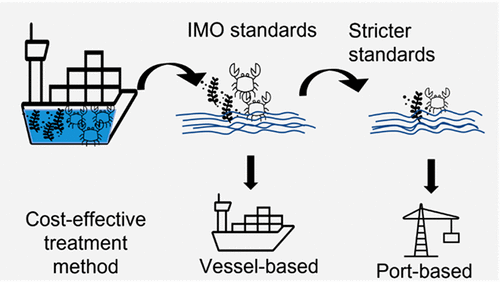当前位置:
X-MOL 学术
›
Environ. Sci. Technol.
›
论文详情
Our official English website, www.x-mol.net, welcomes your feedback! (Note: you will need to create a separate account there.)
Integrated Biological Risk and Cost Model Analysis Supports a Geopolitical Shift in Ballast Water Management
Environmental Science & Technology ( IF 11.4 ) Pub Date : 2021-09-14 , DOI: 10.1021/acs.est.1c04009 Zhaojun Wang 1 , Mandana Saebi 2 , James J Corbett 1 , Erin K Grey 3 , Salvatore R Curasi 4
Environmental Science & Technology ( IF 11.4 ) Pub Date : 2021-09-14 , DOI: 10.1021/acs.est.1c04009 Zhaojun Wang 1 , Mandana Saebi 2 , James J Corbett 1 , Erin K Grey 3 , Salvatore R Curasi 4
Affiliation

|
This work evaluates efficacies of plausible ballast water management strategies and standards by integrating a global species spread risk assessment with a policy cost-effectiveness analysis. Specifically, we consider species spread risks and costs of port- and vessel-based strategies under both current organism concentration standards and stricter standards proposed by California. For each scenario, we estimate species spread risks and patterns using a higher-order analysis of a global ship-borne species spread model and estimate fleet costs for vessel- and barge-based ballast water treatment systems for each standard. We find that stricter standards may reduce species spread risk by a factor of 17 globally and would greatly simplify the complex network of ship-borne species spread. The current policy of IMO standards is most cost-effectively achieved through ship-based treatment, and that any additional risk reduction will be most cost-effectively achieved by port-based (or barge-based) technologies, particularly if these are strategically implemented at the top ports within the largest clusters. Barge-based ballast water management would require a shift in governance, and we suggest that this next level of policymaking could be feasible for special areas designated by the IMO, by State or multistate authorities, or by voluntary port applications.
中文翻译:

综合生物风险和成本模型分析支持压载水管理的地缘政治转变
这项工作通过将全球物种传播风险评估与政策成本效益分析相结合来评估合理的压载水管理策略和标准的有效性。具体而言,我们考虑了当前生物浓度标准和加利福尼亚提出的更严格标准下基于港口和船舶的策略的物种传播风险和成本。对于每种情况,我们使用全球船载物种传播模型的高阶分析来估计物种传播风险和模式,并估计每个标准下基于船舶和驳船的压载水处理系统的船队成本。我们发现,更严格的标准可以将全球物种传播风险降低 17 倍,并将大大简化复杂的船载物种传播网络。IMO 标准的当前政策通过基于船舶的处理最经济有效地实现,并且任何额外的风险降低都将通过基于港口(或基于驳船)的技术最经济有效地实现,特别是如果这些技术在最大集群中的顶级端口。基于驳船的压载水管理需要转变治理方式,我们建议对于 IMO、州或多州当局或自愿港口申请指定的特殊区域,下一级政策制定可能是可行的。
更新日期:2021-10-06
中文翻译:

综合生物风险和成本模型分析支持压载水管理的地缘政治转变
这项工作通过将全球物种传播风险评估与政策成本效益分析相结合来评估合理的压载水管理策略和标准的有效性。具体而言,我们考虑了当前生物浓度标准和加利福尼亚提出的更严格标准下基于港口和船舶的策略的物种传播风险和成本。对于每种情况,我们使用全球船载物种传播模型的高阶分析来估计物种传播风险和模式,并估计每个标准下基于船舶和驳船的压载水处理系统的船队成本。我们发现,更严格的标准可以将全球物种传播风险降低 17 倍,并将大大简化复杂的船载物种传播网络。IMO 标准的当前政策通过基于船舶的处理最经济有效地实现,并且任何额外的风险降低都将通过基于港口(或基于驳船)的技术最经济有效地实现,特别是如果这些技术在最大集群中的顶级端口。基于驳船的压载水管理需要转变治理方式,我们建议对于 IMO、州或多州当局或自愿港口申请指定的特殊区域,下一级政策制定可能是可行的。



























 京公网安备 11010802027423号
京公网安备 11010802027423号